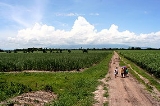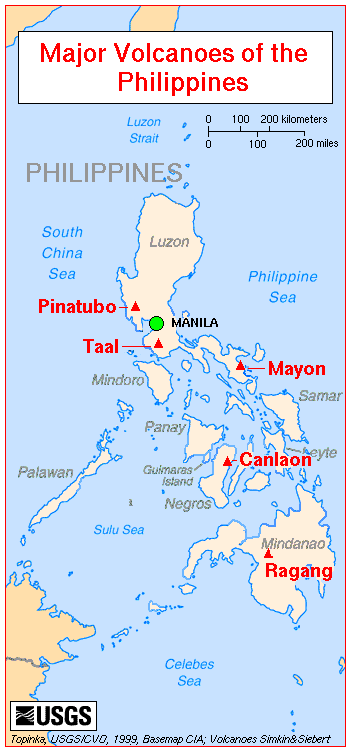
Kanlaon
Encyclopedia

Volcano
2. Bedrock3. Conduit 4. Base5. Sill6. Dike7. Layers of ash emitted by the volcano8. Flank| 9. Layers of lava emitted by the volcano10. Throat11. Parasitic cone12. Lava flow13. Vent14. Crater15...
on Negros island in central Philippines
Philippines
The Philippines , officially known as the Republic of the Philippines , is a country in Southeast Asia in the western Pacific Ocean. To its north across the Luzon Strait lies Taiwan. West across the South China Sea sits Vietnam...
. The stratovolcano
Stratovolcano
A stratovolcano, also known as a composite volcano, is a tall, conical volcano built up by many layers of hardened lava, tephra, pumice, and volcanic ash. Unlike shield volcanoes, stratovolcanoes are characterized by a steep profile and periodic, explosive eruptions...
straddles the provinces
Provinces of the Philippines
The Provinces of the Philippines are the primary political and administrative divisions of the Philippines. There are 80 provinces at present, further subdivided into component cities and municipalities. The National Capital Region, as well as independent cities, are autonomous from any provincial...
of Negros Occidental
Negros Occidental
Negros Occidental is a province of the Philippines located in the Western Visayas region. Its capital is Bacolod City and it occupies the northwestern half of Negros Island; Negros Oriental is at the southeastern half...
and Negros Oriental
Negros Oriental
Negros Oriental is a province of the Philippines located in the Central Visayas region. It occupies the south-eastern half of the island of Negros, with Negros Occidental comprising the north-western half. It also includes Apo Island — a popular dive site for both local and foreign tourists...
, approximately 30 km (18.6 mi) southeast of Bacolod City
Bacolod City
The City of Bacolod , is a highly urbanized midsize Philippine city. It is the capital of the Negros Occidental province. Having a total of 499,497 inhabitants as of August 1, 2007, it is the most populous city in the Western Visayas Region. It is currently ranked as the 17th most populous city in...
, the capital and most populous city of Negros Occidental.
The volcano is a favorite spot for mountain climbers and is the centerpiece of Mt. Kanlaon Natural Park, a national park originally established on August 8, 1934. It is one of the active volcanoes in the Philippines
Active volcanoes in the Philippines
Active is commonly termed for volcanoes with historical eruptions. Moreover, the Philippine Institute of Volcanology and Seismology classify active volcanoes in the country as having erupted within historical times , with accounts of these eruptions documented by man; or having erupted within the...
and part of the Pacific ring of fire
Pacific Ring of Fire
The Pacific Ring of Fire is an area where large numbers of earthquakes and volcanic eruptions occur in the basin of the Pacific Ocean. In a horseshoe shape, it is associated with a nearly continuous series of oceanic trenches, volcanic arcs, and volcanic belts and/or plate movements...
.
Physical features
Kanlaon has a peak elevation of 2435 m (7,988.8 ft) with a base diameter of 30 km (18.6 mi) and is dotted with pyroclastic cones and craters. Just below and north of the summit is the active Lugud crater. North of Lugud is a 2 by calderaCaldera
A caldera is a cauldron-like volcanic feature usually formed by the collapse of land following a volcanic eruption, such as the one at Yellowstone National Park in the US. They are sometimes confused with volcanic craters...
, known as Margaja Valley, with a crater lake
Crater lake
A crater lake is a lake that forms in a volcanic crater or caldera, such as a maar; less commonly and with lower association to the term a lake may form in an impact crater caused by a meteorite. Sometimes lakes which form inside calderas are called caldera lakes, but often this distinction is not...
.
The volcano has three hot springs
Hot Springs
Hot Springs may refer to:* Hot Springs, Arkansas** Hot Springs National Park, Arkansas*Hot Springs, California**Hot Springs, Lassen County, California**Hot Springs, Modoc County, California**Hot Springs, Placer County, California...
on its slopes: Mambucal Hot Springs on the northwest, Bucalan Hot Spring, Bungol Hot Spring. Its adjacent volcanic edifices are Mt. Silay
Silay (volcano)
Silay stratovolcano is a potentially active volcano on Negros Island in the Philippines.-See also:* Active volcanos in the Philippines* Potentially active volcanos in the Philippines* Inactive volcanos in the Philippines...
and Mt. Mandalagan
Mandalagan
Mandalagan is located at latitude 10.65° North , longitude 123.25° East , in the province of Negros Occidental, on the north of the island of Negros, Region VI, of the Philippines....
, north of Kanlaon.
The city center of Canlaon City
Canlaon City
Canlaon City is a 4th class city in the province of Negros Oriental, Philippines. According to the 2000 census, it has a population of 46,548 people in 9,302 households. Canlaon is located 168 km from the provincial capital Dumaguete...
, the city that has jurisdiction on the Negros Oriental
Negros Oriental
Negros Oriental is a province of the Philippines located in the Central Visayas region. It occupies the south-eastern half of the island of Negros, with Negros Occidental comprising the north-western half. It also includes Apo Island — a popular dive site for both local and foreign tourists...
side of the mountain, lies on its lower slope about 8.5 km (5.3 mi) ESE of the summit.
Eruptions
The most active volcano in central Philippines, Kanlaon has erupted 26 times since 1886. Eruptions are typically phreaticPhreatic
The term phreatic is used in Earth sciences to refer to matters relating to ground water below the water table . The term 'phreatic surface' indicates the location where the pore water pressure is under atmospheric conditions...
explosions of small-to-moderate size that produce minor ashfalls near the volcano. In 1902, the eruption was classified as strombolian
Strombolian eruption
Strombolian eruptions are relatively low-level volcanic eruptions, named after the Italian volcano Stromboli, where such eruptions consist of ejection of incandescent cinder, lapilli and lava bombs to altitudes of tens to hundreds of meters...
, typified by the ejection of incandescent cinder
Cinder
A cinder is a pyroclastic material. Cinders are extrusive igneous rocks. Cinders are similar to pumice, which has so many cavities and is such low-density that it can float on water...
, lapilli
Lapilli
Lapilli is a size classification term for tephra, which is material that falls out of the air during a volcanic eruption or during some meteorite impacts. Lapilli means "little stones" in Latin. They are in some senses similar to ooids or pisoids in calcareous sediments.By definition lapilli range...
and lava bombs.
Volcanic activity at Kanlaon is continuously monitored by the Philippine Institute of Volcanology and Seismology
Philippine Institute of Volcanology and Seismology
The Philippine Institute of Volcanology and Seismology is a Philippine national institution dedicated to provide information on the activities of volcanoes, earthquakes and tsunamis, as well as other specialized information and services primarily for the protection of life and property and in...
(PHIVOLCS), the government's bureau that monitors the volcano and earthquakes in the country. Kanlaon Volcano Observatory is located at the campus of La Carlota City College in Bgy.
Barangay
A barangay is the smallest administrative division in the Philippines and is the native Filipino term for a village, district or ward...
Cubay, La Carlota City
La Carlota City
La Carlota City is a 3rd class city in the province of Negros Occidental, Philippines. According to the 2007 census, it has a population of 65,669 people in 13,497 households. The city was known as Simancas until 1871, two years after its foundation...
in Negros Occidental province.
The 1996 fatal accident on Kanlaon
On August 10, 1996, a group of of 24 mountain climbers were on the summit of the volcano when Kanlaon suddenly erupted without any warning killing BritishUnited Kingdom
The United Kingdom of Great Britain and Northern IrelandIn the United Kingdom and Dependencies, other languages have been officially recognised as legitimate autochthonous languages under the European Charter for Regional or Minority Languages...
student Julian Green and Filipinos Noel Tragico and Neil Perez, who were trapped near the summit. The authorities rescued the 17 others, including 10 Belgians, another Briton
Briton
- Peoples :* British people, citizens of the United Kingdom, the Isle of Man, the Channel Islands, or of one of the British overseas territories* Britons , ancient Celtic people from the island of Great Britain- Newspapers :...
and six Filipinos. The 17 were identified as Belgians Frederick Carraso, Philipp Couche, Caroline La Grange, Sophie La Benne, Darmien Gaitan, David Ryckaert, Florence De Corte, Jean Francois Ossengeld, Caroline Verlinde and Delthme Ferrant, Briton Gordon Cole and Filipinos Pepito Ibrado, Wovi Villanueva and Albert Devarras.
One of the Belgians, Caroline Verlinde, said she and her group were about to leave a site near the crater rim when suddenly the volcano ejected ash and stones. She ran to a tree for cover and saw her friends being hit by falling stones. She said their Filipino guide told them the smoke billowing out from the crater "was just ordinary."
2006
On June 3, 2006, Kanlaon again exhibited restiveness and spewed steam and ash. , issued Alert Level 1 (mild restiveness) on June 12, 2006.2008
On February 10, 2008 PHIVOLCS issued an alert stating that the seismic network at Kanlaon Volcano recorded a total of 21 low frequency volcanic earthquakes (LFVQ) during the past 24 hours. Due to the increasing number of recorded volcanic earthquakes, PHIVOLCS raised Kanlaon Volcano’s alert status from Alert Level 0 to Alert Level 1, which means the volcano is at slightly elevated unrest and volcanic activity could lead to steam and ash ejections. A 4 kilometres (2.5 mi) Permanent Danger Zone (PDZ) was maintained around the volcano, as sudden explosions may occur without warning, but no eruptions occurred.2009
In the 8 days from 23 August to 1 September, 257 volcanic earthquakes were recorded. Usual seismic activity during quiet periods is 0 to 4 quakes in any 24 hour period. EpicenterEpicenter
The epicenter or epicentre is the point on the Earth's surface that is directly above the hypocenter or focus, the point where an earthquake or underground explosion originates...
s of the recorded quakes were clustered at the north-west slope which may indicate movement of an active local fault at the slope induced by pressure beneath the volcano. Surface observations did not show any significant change in the steam emission from the crater. PHIVOLCS maintained the alert status at Level 0.
See also
- Active volcanoes in the PhilippinesActive volcanoes in the PhilippinesActive is commonly termed for volcanoes with historical eruptions. Moreover, the Philippine Institute of Volcanology and Seismology classify active volcanoes in the country as having erupted within historical times , with accounts of these eruptions documented by man; or having erupted within the...
- Potentially active volcanoes in the Philippines
- Inactive volcanoes in the Philippines

